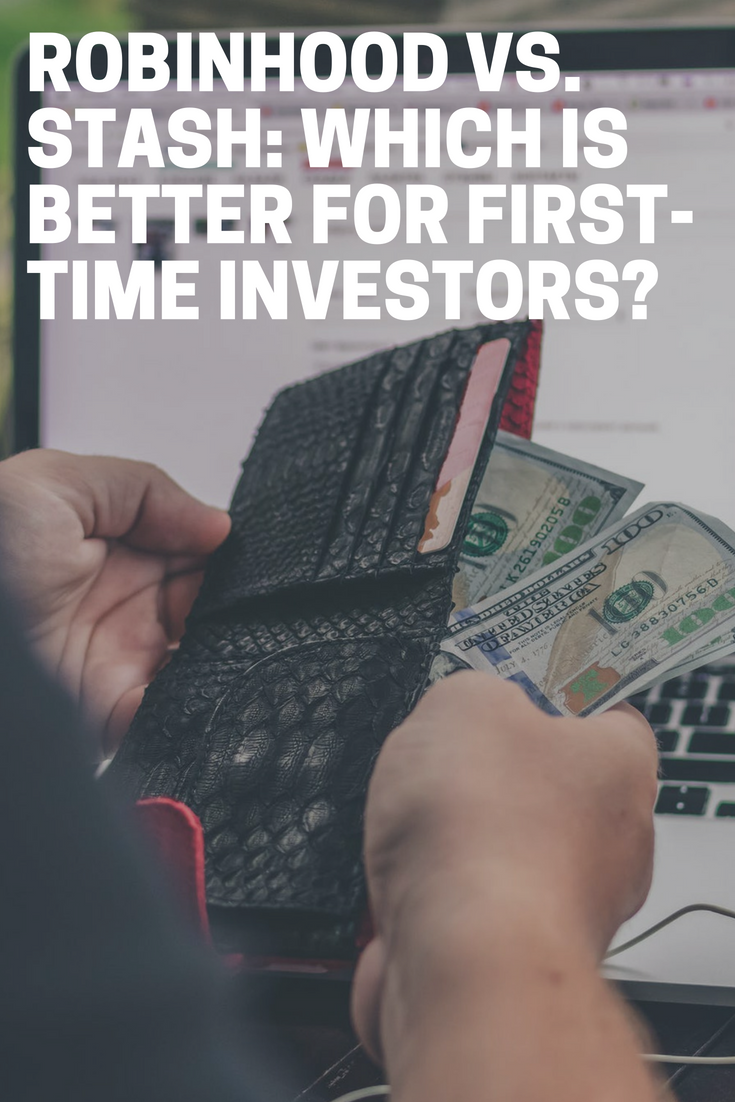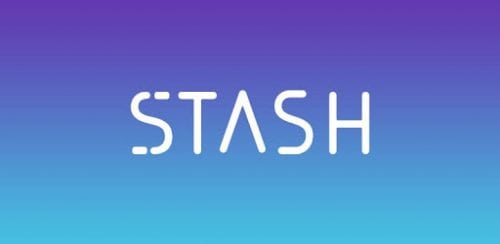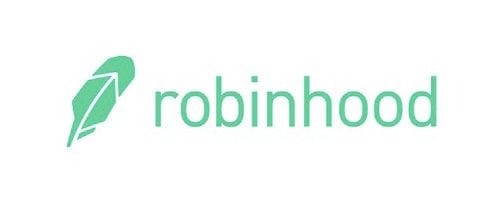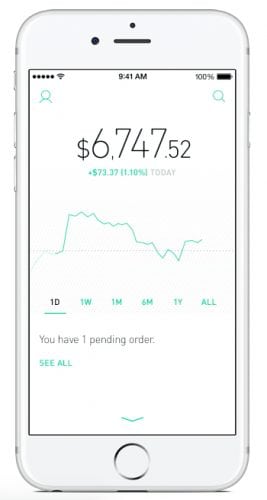When you ask millennials on the street and interview them about investment, there is a huge chance that they will just stare at you with a blank face and slowly back away from you.
According to a research conducted by Bankrate, one out of three millennials have investments in the stock market. That already includes the people who invest via a retirement account or a mutual fund. Some millennials say that they do not have enough money (or still have too much debt from student loans) or that they do not have any idea about bonds and stocks.

Overview
While there are a lot of new online investment services available, this article will look at two applications that specifically targets first-time investors that would want to invest in the stock market. The two apps are Stash and Robinhood.
The two apps have the same goals and have the same tactics when it comes to marketing, however, they take different approaches for those who are investing for the first time. This article will determine whether one or both of these apps will be a winner for the millennial investor by looking at how these two manage the biggest concerns of the millennials: education and cost.
If you are not sure about the ways to get started when investing or if you do not have wads of cash that are weighing you down, then Stash and Robinhood are good places to start with.
Stash
Stash is also known as Stash Investment. It is an Android and iOS app that enables investor to start investing with as little as $5 dollars. It enables the users to purchase fractional shares among a curated selection of exchange-traded funds (ETFs).

Basically, purchasing shares of an ETF enables you to acquire a small portion of a bigger fund that holds various stocks. As an example, a common ETF in most portfolios is the Vanguard S&P; 500 ETF which purchases stocks from all the 500 companies on the S&P; 500. Stash enables you to purchase a fractional share, which means that you acquire just a small part of an ETF that is more expensive.
Stash is intended to move investor away from thinking about individual stocks. Instead, Stash would want investors to think about their portfolio in terms of what they want, believe, or like. Those are literally the categories that the team of Stash have organized their ETFs into – I Want, I Believe, and I Like. Stash also renames the ETFs to suit those categories. The First Trust NASDAQ Cybersecurity ETF, for example, is called the “Data Defenders,” and is included under the I Believe tab.
The users of Stash Invest are charged with $1 per month until the balance of their accounts reaches $5,000 where it changes the charge to 0.25% of the balance of your account.
Robinhood
Robinhood is an online stock brokerage that is similar to competitors such as E-Trade or TD Ameritrade. Robinhood, unlike its competitors, enables its users to purchase ETFs and shares of stocks with no commission and without the need to maintain a minimum account balance.
Robinhood is a stock brokerage company with a twist. Not like most stock brokers who provide downloadable desktop and/or web-based dashboards to facilitate the trading, Robinhood is a mobile app that allows you trade using your mobile phone.

The is no curation on Robinhood unlike Stash, this is a real deal as you have a direct access to purchase and sell more than 5,000 U.S. listed stocks and ETFs.
The interface of Robinhood highlights real-time market information, but not much else. If you navigate to a particular stock, you will find the most recent headlines and some statistics regarding the performance of the stock, but not much in the manner of in-depth guidance or research for first-timers.
Using Robinhood will not cost you anything. A monthly subscription to Robinhood Gold is optional. The subscription is a margin account that is intended for the advanced users. However, unlike Stash, you must have sufficient money in your account to acquire a full ETF or share of a stock.
Which App Should I Use If I Don’t Have Much Money?
The number one concern of millennial investors is money. If you feel like you do not have a lot of money to begin investing. You will possibly be enticed to the promise of Stash that you can begin investing with only $5. It is a very low-risk way to begin by placing $5 or more into a different kind of ETF per week while you are watching you portfolio improve over time.
However, if you are conscious about money, you might not like the $1/month charge of Stash. That may seem low on the surface but it is actually a large fee. If you invest $5 per week, you will have to place roughly $260 during your first year.
With an annual fee of $12, you are already paying 4.6% of your portfolio as a fee. This will not consider the growth in your account, but even if your account improves by 8%, which is already the highest growth that the “Potential” calculator of Stash will let you go, your earnings would not even cover for half of the fee.

Other competitors such as Wealthfront, Wealthsimple, and Betterment charge between 0.25% and 0.5% with no minimum deposit, or around 65 cents on a deposit amounting to $260.
For an app that aims at first-time investors who are making small contributions over time, the fee appears to be almost criminal. This charge only begins to make sense once you begin contributing more and more money.
Additionally, not like other online services such as Wealthfront or Betterment, Stash takes this charge out of your bank account, and not out of your portfolio. That means that in addition to whatever money you are investing into Stash each month, you are re getting more money taken out for the fee. You must take that into account when you are budgeting.
For a number of investors, being able to purchase fractional shares may be well worth the relatively costly fee. Not only does it allow you to invest in funds that you otherwise would not be able to afford, but it also guarantees that each dollar that you place into your account will be invested.
On the other hand, if these remains to be your main concern, you are probably better off with an account with Betterment. While Betterment only allows you to pick from a set portfolio of ETFs, they also offer some fractional shares that do not require you to maintain a minimum account balance, and only charge an annual fee of 0.25% for their basic account.
You could also just place $5 per week into Robinhood instead. Since Robinhood is absolutely free to use, you can invest as much or as little cash into it without being concerned about incurring some king of fee. Of course, the huge risk with Robinhood is that your money will only be sitting there for a long time while you are saving enough to purchase your first ETF or stock, which can be a massive psychological drag.

However, if you are looking for some low-priced ETFs to begin inveting with, you can take a look at Stash for some inspiration but you can buy through Robinhood. The “Data Defenders” ETF that was mentioned earlier is trading at about $21 currently. Most of their options cost less than $100 per share. You can also visit other sites such as the database of ETFs called ETFdb.com. There is a huge world of ETFs that are beyond what is offered by Stash, and you can get most of them via Robinhood.
So the winner for small investments is Robinhood since it is literally free. The $1/month fee of Stash is relatively high compared to what you are getting, and you should seriously be thinking about other options prior to committing to Stash in the long-term. If you like the concept of fractional shares, you should consider Betterment instead. But if you want to choose your own stocks and ETFs, you should check out the services of Robinhood.
As a side note, you should be aware the hidden costs that are charged by ETFs. Majority of ETFs have a fee that is associated with owning them that is separate than the fee that you would be required to pay Betterment or Stash. This charge is called an expense ratio, a payment for the management of the fund.

Some of the fees are incredibly low – for example, Vanguard, is well known for charging expense fees under 0.1%. Some of the ETFs that are featured by Stash have expense ratios that are much higher. For example, “Robots Rising” has a 0.95% expense ratio and “Data Defenders” has an expense ratio amounting to 0.6%. Even though these fees seem to be relatively low, they will surely add up in the long run!
Quick Comparisons
Each of these mobile apps has its own unique twist on investing in the stock market but both do an awesome job with catering to beginner investors.
While Robinhood concentrates on reducing the barrier to investing to virtually nil by not charging commissions costs when you sell and buy ETFs and stocks, Stash focuses on thematic investments that are aligned with your values, and throws in free and top notch education for good measure.
| Robinhood | Stash | |
| Standout Feature | Zero Commission Trading | Great for Beginning Investors |
| Commissions | Stocks & ETFs: $0 | $1/month to 0.25% |
| Account Balance Minimum | $0 | Starting at $5 |
Fees
Stash charges $1 monthly for amounts that are $5,000 below and 0.25% of assets on amounts of $5,000 and above. Robinhood charges no commission costs for stock and ETF transactions.
Not like the robo-advisors that automate the process of the investment of your money, Robinhood and Stash allow you to have control over the selections of your investment.
| Amount | Robinhood | Stash |
| < $5,000 | Stocks & ETFs: $0 | $1/month (Stash standard)
$2/month (Stash Retire) |
| $5,000+ | Stocks & ETFs: $0 | 0.25% |
How Fees are Charged
Unlike majority of the other robo-advisors and brokers, Stash charge fees to your bank balance.
For most users, the fees would not be so high as to become a cause of concern that cash reserves will be decreased. However, it is less than ideal as compared to the normal fee charges in the industry where the costs are directly deducted in the investment account.
Account Types
Both Stash and Robinhood cater to taxable account. But unlike Robinhood, Stash also offers retirement Roth IRA accounts. You can also contribute after-tax dollars to Roth IRA accounts and grow your earnings tax-free. When you make withdrawals on your account, the monies will not be taxed – unlike a traditional IRA which is funded using pre-tax dollars.
Education
Stash offers an extensive library of educational material that is aimed to help you make better decisions on your investment. Even though it is not catalogued in a particularly structured manner, the information that you might be looking for to help in assessing the benefits of a particular investment over another will be pretty much at your fingertips.

If you can put aside the somehow haphazard selection of articles, the quality of the information that are provided is excellent and superior to Robinhood.
So, if you have an idea on what you want to invest in and cost is your main concern, then Robinhood will be the better bet, but if you are not sure on how to allocate your money and want to become better at improving your nest-egg then Stash will be the better option.
Stash or Robinhood: The Pros
Robinhood and Stash stand out in different areas so the investment app that you will opt for is largely dependent on which of the features will best serve your needs and requirements.
| Robinhood | Stash |
| Low Account Minimum: You can open an account with Robinhood without shedding a dime. However, to invest you will obviously be required to deposit some cash. Also, to trade on margin, the minimum required is $2,000. | Education: Stash offers an extensive library of valuable information that will help you make better investing decisions. |
| No Commissions: What is not to love about paying no costs on commissions. Robinhood would win hands down on cost against just about all of its competition. Margin trading, however, comes at a monthly cost that starts at $6. | Thematic Investments: You can easily choose between dividend paying blue chips, stocks, conservative stocks, global stocks, environmentally-friendly stocks, and a host of others. |
| Margin Trading: Traders who are adventurous and can tolerate more risk have the option to amplify your gains by using margin at Robinhood. But you should be aware that the risks increase too. | Easy Navigability: Stash is not the easiest app to set up. However, when you are already in, it is highly intuitive to learn, make more deposits, and even automate recurring deposits using Auto-Stash. |
| Easy Setup: Setup is fast, account verification is speedy, and cash transfers are all straightforward at Robinhood. | Social Connectivity: After making a trade, you can easily share your investment selections on Facebook (account balances and portfolio value will remain private). |
| Mobile Friendly: Whether on an Android phone or an iPhone, Robinhood will be compatible. | Mobile Friendly: Android and iOS users can both use Stash. |
Conclusion
On determining which among Stash and Robinhood is the best investment app, it will depend on how fee sensitive you are. And the answer will be obvious.
- Robinhood cannot be beaten when it comes to price. However, where Robinhood shines on cost, it loses some marks on extra whistles and bells . It does win points for making margin trading available to those investors that are seeking risks.
- Stash is somehow affordable and charges some fees in line with the norms of the industry, and it also has some other benefits such as thematic investing at the touch of a button, automated monthly investing, and extensive educational resources. You can also easily share your investment selections on social media using Stash.
So, which of the two apps is better? We give the verdict to Stash, assuming that the monthly fee of $1 for amounts under $5,000 and 0.25% charge on amounts amounting to $5,000 and above are reasonable to you.



